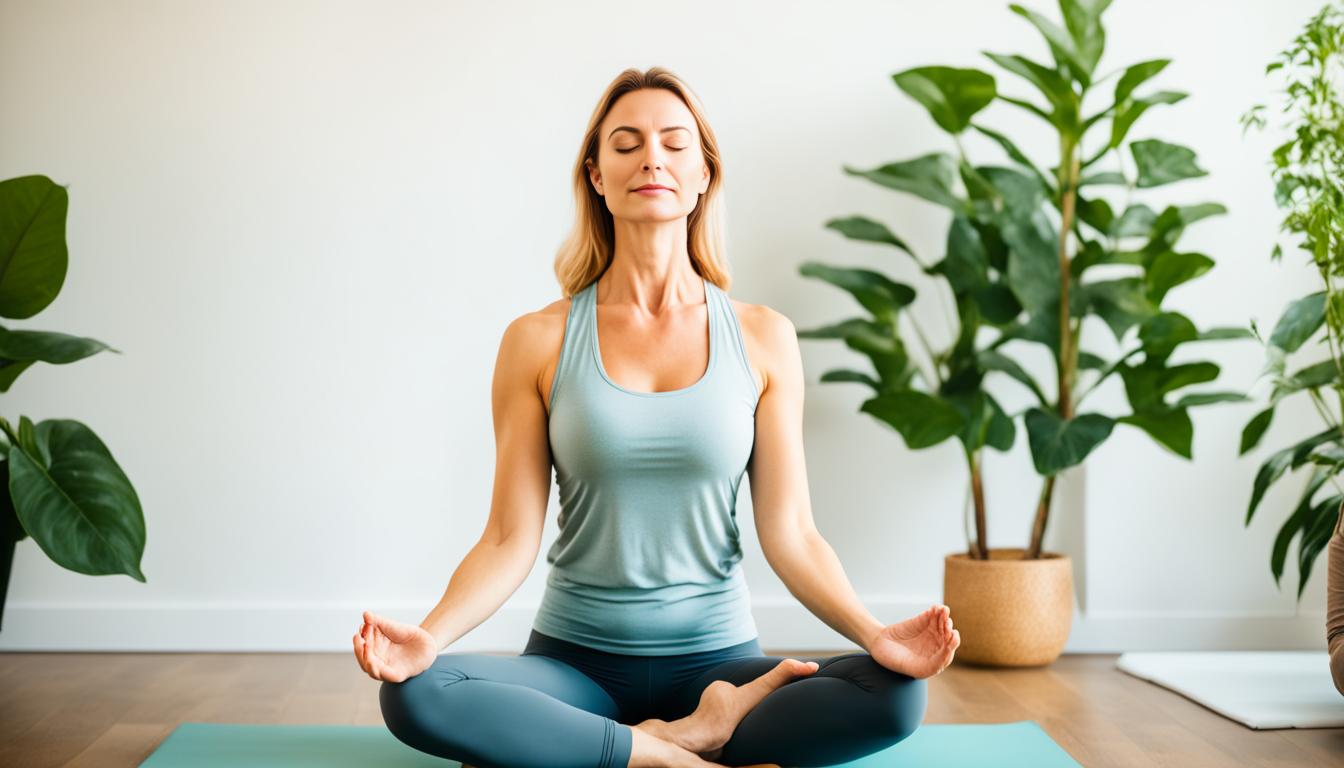Embarking on the path of yoga can be a transformative experience, offering a multitude of benefits for both the body and mind. Yoga for beginners doesn’t have to be daunting; instead, it’s a welcoming invitation to explore personal growth and wellness. Whether you’re looking to increase flexibility, build strength, or find serenity, starting yoga practice can be the first step to a more balanced life.
There’s a reason why yoga basics have stood the test of time—they form the foundation of a practice that is both enriching and accessible. With beginner-friendly yoga, the focus is on learning at your own pace and honoring the body’s needs. This ensures a safe and enjoyable experience as you unfold the layers of this ancient discipline.
Key Takeaways
- Understanding that yoga is accessible to all skill levels and abilities.
- Emphasis on the importance of starting your yoga journey with foundational knowledge.
- Encouragement to embrace yoga as a holistic practice for mind and body health.
- Importance of creating a personal yoga practice that aligns with individual needs.
- Highlighting the rich tradition of yoga to enhance the practice’s significance for beginners.
Understanding the Foundations of Yoga
Diving into the essence of yoga unveils a rich tapestry interwoven with spiritual depth, diverse practices, and undeniable benefits. The relationship between yoga for mind and body is as ancient as it is dynamic, echoing principles that have stood the test of time. From understanding its profound history to exploring the myriad branches that form types of yoga, it is essential to grasp the roots to truly appreciate the practice’s transformative potential.
L’histoire et la philosophie derrière le yoga
La création du yoga remonte à des millénaires, avec une histoire du yoga enracinée dans les terres mystiques de l’Inde ancienne. C’est une discipline imprégnée de sagesse, avec une philosophie du yoga offrant un aperçu de la nature de l’existence, de la conscience et du chemin vers l’illumination. Les premières écritures comme le Rigveda et les lignes directrices élaborées présentées dans les Yoga Sutras de Patanjali ont jeté les bases du yoga comme moyen de fusionner le moi individuel avec l’esprit universel.
Les différents types de yoga expliqués
Whether seeking physical vigor or spiritual tranquility, there is a form of yoga aligning with every intention. Hatha yoga focuses on physical postures and breathing, making it ideal for beginners. Vinyasa, with its fluid movement sequences, offers a more dynamic practice. Ashtanga’s structured approach challenges the practitioner, while Iyengar emphasizes alignment and precision. Restorative yoga, on the other hand, provides a gentle, healing experience. The diversity of types of yoga ensures that anyone can find a practice that resonates with their unique needs.
How Yoga Benefits Your Mind, Body, and Spirit
The benefits of yoga go far beyond flexibility and strength. On a physical level, consistent practice enhances mobility, reduces chronic pain, and promotes overall health. Mentally, yoga is a sanctuary for stress relief, improved focus, and mental clarity. Spiritually, it fosters a deep sense of peace, mindfulness, and an enduring connection with the inner self, establishing harmony in every facet of life.
With the rolling mat as its landscape, yoga offers a wealth of practices, each designed to nurture the practitioner’s wellbeing. Here is an illustrative table to encapsulate the powerful yoga for mind and body synergy.
| Type of Yoga | Key Focus | Benefits |
|---|---|---|
| Hatha Yoga | Postures (Asanas) and Breathing (Pranayama) | Builds strength, enhances flexibility, promotes relaxation |
| Vinyasa Yoga | Flowing movements with breath | Increases cardiovascular health, improves stamina and balance |
| Ashtanga Yoga | Structured asana sequences | Encourages discipline, detoxifies the body, heightens concentration |
| Iyengar Yoga | Precise alignment and timing | Improves posture, deepens body awareness, aids injury recovery |
| Restorative Yoga | Passive stretching with support | Facilitates deep relaxation, reduces stress, and fosters healing |
In conclusion, grounding oneself in the foundations of yoga catalyzes a journey of self-discovery and profound well-being. As the practice continues to evolve, its roots remain a beacon, guiding practitioners towards balance and illumination in the modern world.
Essential Equipment for Your Yoga Practice
Starting a yoga routine can be a transformative experience, and having the right yoga equipment can make all the difference in your practice, especially for those new to yoga. Knowing about the appropriate beginner yoga props can not only enhance your experience but also help maintain proper alignment and prevent injuries.
Laying the foundation for a fulfilling practice begins with selecting the perfect yoga mat. Look for mats with ample cushioning, non-slip surfaces and eco-friendly materials. Following the mat, consider yoga blocks, which are invaluable for beginners. These props assist in balancing, provide support in poses that are currently out of reach, and help deepen stretches.
To complete your yoga equipment toolkit, other fundamental accessories include:
- A durable yoga strap, which aids in achieving proper form and extending your reach
- Supportive yoga bolsters for restorative poses and meditation
- Comfortable, breathable yoga clothes to allow for full range of motion
- A yoga blanket for extra padding and warmth during cool down sessions
Ensuring you have these beginner yoga props and essentials will facilitate a smooth and comfortable entry into your yoga practice. They bolster your capabilities, allowing for gradual progression in poses and techniques.
N’oubliez pas que même s’il est tentant d’accumuler divers équipements de yoga , la qualité doit toujours l’emporter sur la quantité. Investir dans quelques accessoires fiables pour débutants peut fournir une base solide sur laquelle bâtir à mesure que votre pratique se développe. Une approche minimaliste renforce non seulement les principes du yoga, mais garde également votre espace de pratique bien rangé et votre esprit concentré sur le voyage à venir.
Yoga for Beginners: Creating Your Space
The journey of yoga begins with a single pose—and where better to embark on this transformative path than within the comfort and privacy of your own home? For many, especially those new to the practice, creating yoga space at home is a vital step in establishing a routine. By designing an environment that resonates with the peace and focus synonymous with yoga, you are setting the stage for a fulfilling beginner yoga environment.
Selecting the Ideal Spot for Yoga at Home
Identifying the right location is imperative when creating a yoga space. It’s about more than just clearing a corner in a room; it’s about choosing a spot where you feel at ease and able to disconnect from daily distractions. Look for an area with minimal noise, ample space to move freely, and, if possible, pleasant natural light. This could be an unused guest room, a quiet corner of your living room, or even a tranquil part of your garden or balcony.
Setting the Atmosphere for Focus and Relaxation
The yoga atmosphere within your space matters as much as the physical area itself. Consider incorporating elements that calm the senses and enhance your ability to focus. Soft lighting, perhaps with dimmable options or candles, can create a soothing ambience. Introduce greenery with indoor plants that not only purify the air but also add a touch of nature to your space. And don’t forget about the sense of smell—essential oils like lavender or eucalyptus can be subtly diffused to promote relaxation and mindfulness.
- Choose a serene, inviting location with minimal disturbances
- Ensure the space has enough room for movement and yoga poses
- Incorporate calming decorative elements like plants and artwork
- Use ambient lighting to create a peaceful environment
- Diffuse essential oils to foster a relaxing olfactory experience
With these tips in mind, even yoga novices can craft a personal haven that will nurture their budding practice. Whether it’s unrolling a yoga mat or selecting a soothing playlist, each aspect of your beginner yoga environment is a step towards a more focused and dedicated practice. Embrace the process of creating your unique yoga space at home as part of the wonderful journey into yoga.
Introductory Yoga Sessions: Your First Steps
Se lancer dans l’aventure du yoga est à la fois passionnant et constitue une étape vers un bien-être accru. Le yoga, une discipline ancienne, offre une voie vers une plus grande conscience du corps qui aide à établir une connexion profonde entre l’esprit et le corps. Alors que vous préparez votre première séance de yoga , il est essentiel d’adopter une attitude de patience et d’auto-compassion. N’oubliez pas que le parcours de yoga de chaque individu est unique et que la clé est d’avancer à votre rythme.
How to Approach Your First Yoga Practice
Before taking your first steps onto the mat, it’s important to set intentions that align with your personal goals and to keep an open mind. Begin by familiarizing yourself with some basic poses and breathing techniques through reliable resources. When you arrive at your first class or start a home practice, allow yourself to be fully present, leaving all expectations at the door. This moment is about discovering the joys and challenges of yoga without judgment.
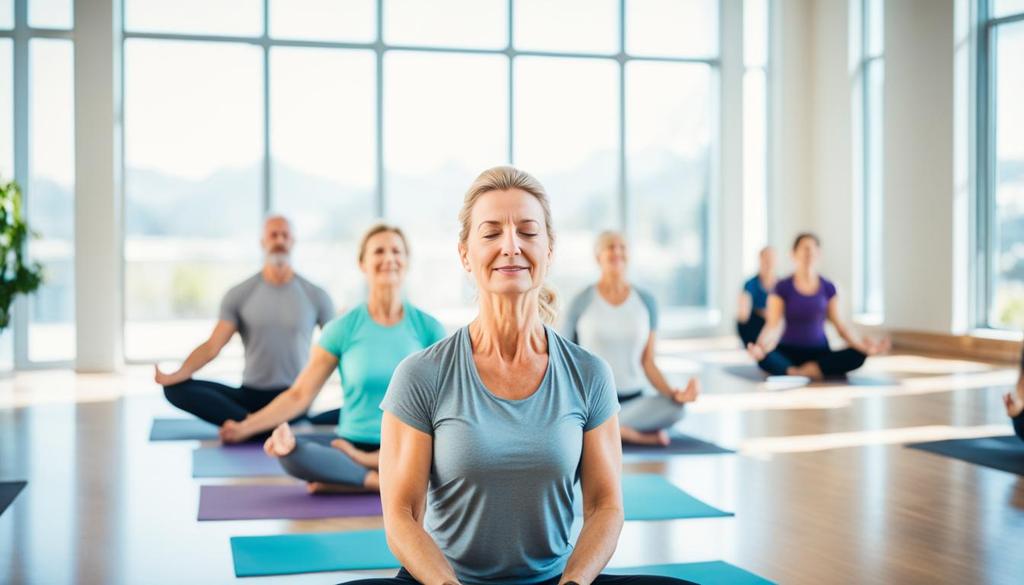
Understanding Your Body’s Limitations and Potential
Your initial experiences with yoga will teach you a lot about body awareness in yoga. It’s crucial to listen to and respect your body’s current limitations, as pushing too hard can lead to discomfort or injury. Start with poses that you find doable, gradually exploring your range of motion and building up from there. Remember, yoga is not a competition—it is a personal practice that evolves with regular practice and time.
| Focus Area | For Body Awareness | For Limitation Respect |
|---|---|---|
| Physical Alignment | Be conscious of aligning your joints and spine correctly in each pose | Adjust poses as needed to avoid strain |
| Breathing | Use breath as a guide to ensure you’re not overexerting | If breathing is strained, ease up on the intensity of your practice |
| Mental Engagement | Maintain focus on how different parts of your body feel during each pose | Accept where you are in your practice without self-criticism |
| Emotional Awareness | Embrace the emotions that arise during your practice | Give yourself grace and take breaks as needed |
As you continue with your yoga journey, you’ll notice an increase in strength, flexibility, and a more profound sense of inner peace. Starting yoga practice is a transformative experience that can blossom into a lifelong passion for personal growth and self-care. So, take that first step with confidence, and enjoy the myriad benefits that yoga will bring into your life.
Core Principles of Yoga for Newcomers
Entering the world of yoga, newcomers often encounter a panorama of practices that stretch beyond the physical postures—into the realm of moral and ethical guidance. Yoga principles are not just exercises for the body but profound teachings for cultivating harmony in life. The foundation of yoga practice is punctuated by precepts that enrich one’s journey from the mat to everyday activities. Understanding these principles provides a structure that supports the holistic upliftment of the individual.
“Yoga is the journey of the self, through the self, to the self.” – The Bhagavad Gita
At the heart of the yoga principles lie the Yamas and Niyamas, which serve as the ethical compass for practitioners. For yoga for newcomers, recognizing the impact of these principles is crucial. They foster an environment of self-awareness and communal respect that is essential for personal growth.
- Ahimsa (Non-violence): More than just physical non-harm, Ahimsa invites practitioners to embrace kindness and compassion towards themselves and others in thoughts, words, and actions.
- Satya (Truthfulness): Commitment to honesty is not just about factual accuracy but also being authentic and genuine with oneself and others, nurturing an atmosphere of trust.
- Tapas (Self-discipline): Revered as the fire that fuels one’s practice, Tapas encourages dedication and perseverance in pursuit of personal betterment.
To further elaborate on how these principles translate into daily practice, consider the table below:
| Principle | Application in Practice | Application in Daily Life |
|---|---|---|
| Ahimsa | Approach each posture with care to avoid injury | Offer support to others without judgment or harm |
| Satya | Recognize your boundaries and honor your truth without comparison | Communicate openly and honestly in relationships |
| Tapas | Maintain a regular practice schedule, cultivating discipline | Set goals and pursue them with consistent, focused effort |
In conclusion, newcomers embracing these core principles find not just a routine but a new lens through which to view and engage with the world. The foundation of yoga practice is thus a versatile groundwork that nourishes both personal and interpersonal dimensions, making the journey one of continuous learning and connection.
Beginner Yoga Poses to Get You Started
Diving into the world of yoga can be both exciting and overwhelming for novices. Embarking on this path requires learning not just the physical postures but also integrating the spiritual and emotional aspects that define the practice. To ensure a solid foundation, we begin by exploring a variety of beginner yoga poses that create a balance of strength, flexibility, and tranquility, setting the stage for a fulfilling journey into yoga.
For those just starting, there is an array of standing yoga poses designed to instill both stability and vigor within the practitioner, while seated yoga poses serve as a means to enhance flexibility and introspection. Aiding in recovery and deep relaxation, restorative yoga poses provide an avenue for healing and rejuvenation—integral to cultivating a well-rounded yoga practice.
Standing Poses for Stability and Strength
Standing poses are a cornerstone in building a strong yoga foundation. They are often used for strengthening the muscles, improving posture, and enhancing balance. These sturdy asanas encourage body awareness and concentration, making them a crucial stepping stone for every yoga novice.

Some fundamental poses that embody these qualities include Mountain Pose (Tadasana), which teaches alignment and grounding, and Warrior II (Virabhadrasana II), which builds leg strength and opens the hips. With regular practice, these poses fortify the body, preparing it for more advanced asanas in the future.
Gentle Seated and Supine Poses for Flexibility
Gently transitioning to the mat, beginners will find solace and stretch in seated and supine poses. These yoga poses are excellent for improving flexibility in the muscles and joints, allowing for a more pliable and less injury-prone physique.
Poses such as the forward-bending Butterfly Pose (Baddha Konasana) and the expansive Seated Forward Bend (Paschimottanasana) invite a deeper connection with the body’s limitations and potentials. They encourage a mindset of patience and gentle progress, which is essential for those at the start of their yoga practice.
Restorative Poses for Relaxation and Healing
Restorative yoga is a practice that emphasizes deep relaxation and healing, a perfect way to end a yoga session or unwind after a stressful day. Utilizing props to support the body in positions of comfort and ease facilitates a deep state of relaxation that promotes yoga for healing. Restorative yoga poses such as the Child’s Pose (Balasana) and Corpse Pose (Savasana) are key for cultivating peace and well-being.
As newcomers embrace these restorative postures, they will witness the transformative effects yoga can have on the mind as well as the body. Through consistent practice, these healing asanas can become powerful tools for coping with stress and chronic tension, paving the way to a more balanced existence.
Whether you are standing firm in a Warrior pose, unfolding gently into a seated stretch, or resting peacefully in Savasana, each asana has a special role in this holistic practice. Beginner yoga poses are not only a physical challenge but also an invitation to explore and nourish the mind and spirit, leaving practitioners feeling centered and replenished.
Simple Yoga Routines for Daily Practice
Embarking on a yoga journey calls for sustainable habits that nurture both body and mind. To achieve this balance, simple yoga routines become the pillars of daily practice. Whether you’re seeking vitality to kickstart your morning or serenity to ease into the night, yoga has the flexibility to accommodate your lifestyle demands. Within this section, you’ll discover straightforward yoga practices designed to energize your mornings, unwind during your evenings, and guidelines for tailoring a personalized yoga sequence that resonates with your individual needs.
Begin with dedication and let yoga’s transformative power bloom within your daily ritual.
A Morning Routine to Energize Your Day
Awakening with the rising sun, a morning yoga routine can infuse your day with a vibrant energy. A sequence involving gentle stretches and stimulating postures awakens the body, promoting alertness and concentration. As you move through sun salutations and energizing standing poses, your body will thank you for the vitalizing start. Let’s explore a sequence that celebrates morning radiance.
A morning yoga session might include a mix of invigorating asanas such as:
- Tadasana (Mountain Pose)
- Uttanasana (Standing Forward Bend)
- Adho Mukha Svanasana (Downward-Facing Dog)
- Virabhadrasana I (Warrior I)
- Utkatasana (Chair Pose)
An Evening Routine for Relaxation
As nightfall approaches, an evening yoga routine serves as an ideal bridge from the day’s hustle to the night’s tranquility. Incorporate gentle, relaxing poses to help soothe tension, calm the nervous system, and prepare the body for a restorative sleep.
An evening practice might be composed of the following poses:
- Balasana (Child’s Pose)
- Supta Baddha Konasana (Reclining Bound Angle Pose)
- Viparita Karani (Legs-Up-The-Wall Pose)
- Paschimottanasana (Seated Forward Bend)
- Savasana (Corpse Pose)
Creating a Personalized Yoga Sequence
Building a personalized yoga sequence empowers you to focus on specific areas, whether you aim to strengthen your core, enhance flexibility, or balance emotions. It involves understanding your unique body rhythm and goals, and weaving them into a sequence that becomes your personal yoga imprint.
Consider starting with foundational poses and gradually introducing variations or targeting different muscle groups each day. Keep in mind to balance the intensity of your poses to match your energy levels and to include both active and restorative asanas for a well-rounded session.
Remember, your yoga practice is a personal journey—one that grows and evolves with you. Embrace the simplicity of these routines and watch your practice deepen day by day.
Yoga Basics: Breathwork and Mindfulness
Embarking on a beginner yoga journey, it’s essential to grasp the importance of yoga breathwork and yoga mindfulness. These practices serve more than just physical functions; they are the threads that weave through the entire fabric of yoga, connecting the mind, body, and spirit. Let’s explore how incorporating these beginner yoga techniques can elevate your practice.
Yoga breathwork, or Pranayama, is the art of breath control. It’s a fundamental part of yoga that helps to improve concentration, calm the mind, and energize the body. Pranayama exercises can range from the simple act of deep breathing to more complex patterns designed to clean the respiratory system and balance energy channels.
Pranayama teaches us to harness the breath, which is the source of our prana, or vital life force. By controlling our breath, we control our energy and, subsequently, our state of being.
Yoga mindfulness, on the other hand, is about being fully present in each moment. Whether holding a pose, flowing through sequences, or sitting in meditation, mindfulness invites us to pay close attention to our experiences without judgment. This attentiveness encourages a deeper connection with our inner self and fosters a state of peace and clarity.
To effectively imbibe these concepts into your sessions, consider the following beginner-friendly practices:
- Start your yoga session by sitting comfortably and focusing on your natural breathing pattern.
- Progress to deep belly breathing, filling the abdomen on the inhale and gently contracting it on the exhale.
- Integrate simple breath control techniques, such as Ujjayi breath, for better focus and heat generation in the body.
- Incorporate mindfulness by moving with attentive grace, aware of every posture’s sensation and alignment.
- Conclude your practice with a few moments of stillness, observing the effects of the practice on your mind and body.
While practicing yoga breathwork, it is not uncommon to uncover a presence of mind often unnoticed in daily life. This heightened awareness is a hallmark of yoga mindfulness, allowing practitioners to experience increased mental clarity and tranquility.
For individuals new to these principles, patience is key. Just as it takes time to develop strength and flexibility in postures, so too does it take practice to master yoga breathwork and yoga mindfulness. With consistent effort, these beginner yoga techniques will not only enhance your yoga practice but also could improve your ability to navigate the complexities of everyday life.
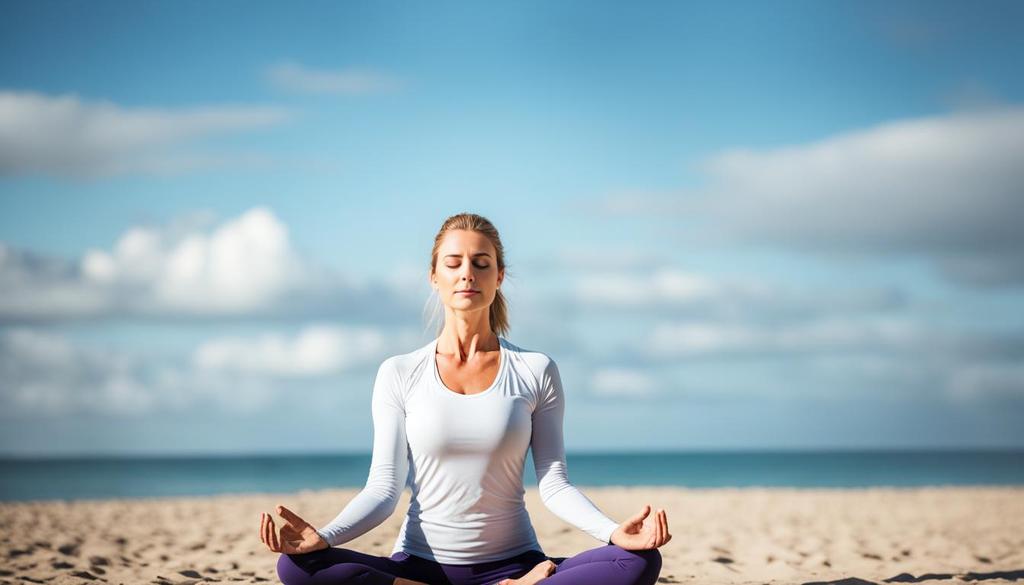
In summary, as you continue to explore yoga, remember that the journey is as rewarding as the destination. By integrating yoga breathwork and yoga mindfulness into your routine, you’re taking significant steps towards achieving a more balanced and harmonious state of being. These practices are the essence of a transformative yoga experience, and they’re accessible to all, regardless of where you are on your yoga path.
Avoiding Common Mistakes in Starting Yoga Practice
Embarking on your yoga journey can be as enlightening as it is fraught with potential mishaps. However, understanding the pitfalls to avoid when starting yoga is key to a fulfilling practice. By emphasizing yoga alignment, preventing yoga injuries, and the virtues of patience in yoga and consistency in yoga, we invite beginners to build a solid foundation for a rewarding yoga experience.
Proper Alignment to Prevent Injury
One of the most common mistakes when stepping into the world of yoga is overlooking the importance of proper alignment. Recognizing the links between correct posture and injury prevention is paramount, as well-directed yoga alignment fosters not only a stronger connection to your practice but also shields you from common injuries. Let’s delve into the vital aspects of maintaining alignment during yoga postures.
Diligence in achieving and sustaining the correct form in each pose is more than just a physical endeavor—it’s a mindfulness practice that pays dividends in physical health. Here are some tips for maintaining alignment:
- Always begin with a proper warm-up to prepare your body for the poses.
- Use mirrors, if available, or the guidance of a knowledgeable instructor to monitor and correct your posture.
- Engage the right muscles for each pose, being mindful not to overextend or force any movements.
- Utilize props such as blocks, straps, and cushions to support your body in maintaining alignment, especially as a beginner.
Understanding the Importance of Patience and Consistency
The journey of yoga is not one of rapid leaps, but rather a steady climb marked by patience and consistency. Realize that mastering yoga does not happen overnight; it’s the sum of consistent practice and an ongoing harmonious dialogue with your body and mind.
“Patience in yoga is the heart’s surrender to each moment, the acceptance that progress is a slow but rewarding walk.” – Noted yoga practitioner.
In pursuit of patience and consistency, consider these pointers:
- Set realistic expectations and honor the unique pace of your body’s progress.
- Establish a regular yoga routine, ensuring that even on days when motivation wavers, discipline keeps you on track.
- Commemorate the small victories, such as holding a pose for a few seconds longer, to encourage a long-term commitment to your practice.
- Remember that rest is just as crucial as action, allowing your body and mind to integrate the benefits of each session.
By intertwining the art of alignment with the grace of patience and the strength of consistency, your yoga practice is sure to evolve from a mere activity to a transformative life experience, reducing the risk of injury and enhancing the depth of your yoga journey.
Progressing in Yoga: When to Advance Your Practice
As practitioners continue their journey, advancing in yoga becomes an enticing prospect that signifies growth. To ensure a smooth yoga progression, it’s essential to recognize the benchmarks signaling a readiness to take on more challenging asanas and philosophies. There are critical markers to consider before deepening your yoga practice.
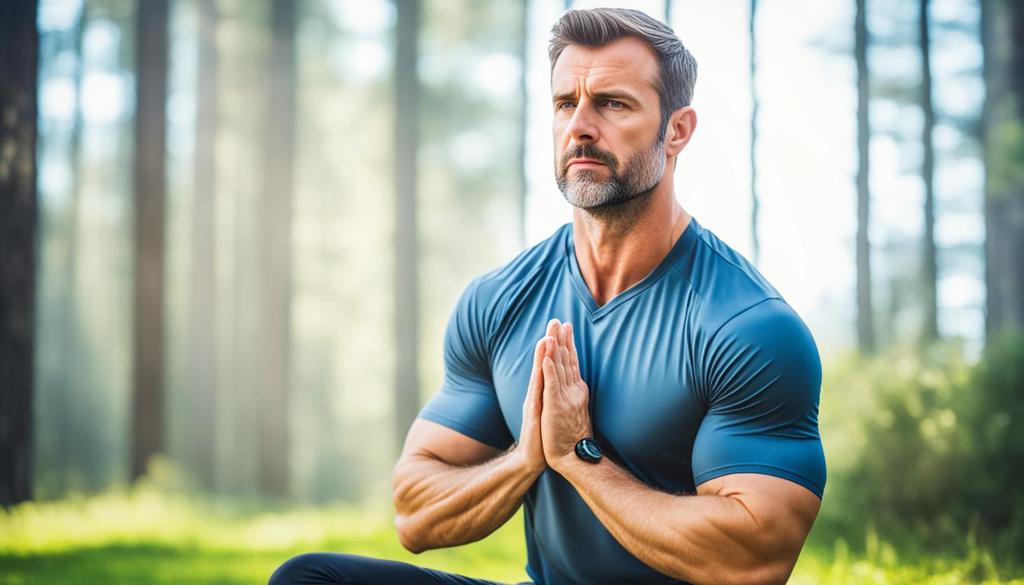
Consistency and Comfort in Basic Poses: Consistency is key; if you find comfort and steadiness in foundational poses, your body may be prepared for further challenges.
Increased Body Awareness: A heightened sense of body awareness, where you can align your body without external guidance, suggests maturity in practice.
Control Over Breathwork: Mastery over breathwork signifies that one has achieved the necessary control and focus for advanced techniques.
To deepen your yoga practice, integrate new elements gradually, prioritizing preservation over ambition to avoid potential burnout or injury.
Advancement in yoga is not just a physical endeavor but also an introspective and philosophical exploration. Listen to your body and mind to gauge the right moment to explore new depths.
| Signs of Readiness | How to Proceed |
|---|---|
| Ease with basic postures | Incorporate intermediate variations |
| Consistent practice | Introduce additional days or sessions |
| Improved strength and flexibility | Try postures that demand more of these qualities |
| Desire for knowledge | Study more complex yoga texts and philosophies |
While seeking to advance, don’t neglect the importance of a holistic approach that involves mind, body, and spirit harmony. Balancing asana practice with meditation and studies in yoga philosophy can lead to a profoundly enriching experience.
Yoga for Beginners: Integrating Yoga into Your Lifestyle
For many beginners, the concept of integrating yoga into daily life seems daunting, yet it can become as natural as any other daily habit. Adopting a yoga habit is less about finding time and more about making time. It’s a shift that can lead to profound changes, not just physically but also for yoga for stress management and as a method of yoga for self-care.
Making Yoga a Habit
The journey of making yoga a part of your everyday routine starts with small, manageable steps. It’s about creating a positive association with your practice, allowing it to blend seamlessly into your lifestyle. Regularity is more crucial than duration; hence, integrating short yoga sessions into your daily schedule can offer significant benefits over time.
- Set a specific time for your practice that aligns with your daily routine.
- Create a welcoming space in your home where you feel at ease to practice.
- Begin with short sessions to gradually build a lasting yoga habit.
- Pair your yoga practice with a regular activity to cue the habit formation.
Utilizing Yoga for Stress Management and Self-care
Living in a fast-paced world, it’s easy to succumb to stress and neglect personal well-being. Yoga has proven to be a valuable ally in managing stress, promoting relaxation, and enhancing self-care practices. It empowers you with techniques to remain calm and centered amidst life’s chaos.
- Adopt breathing exercises (Pranayama) to reduce anxiety and improve focus.
- Include meditative asanas in your practice to facilitate mental relaxation.
- Incorporate restorative yoga poses for deep relaxation and rejuvenation.
- Use yoga as a mindful break from your workday to recharge and refocus.
| Stress Management | Self-Care |
|---|---|
| Daily mindfulness and meditation | Restorative weekly yoga sessions |
| Intentional breathing exercises | Investing time in personal growth |
| Consistent practice for resilience | Creating a self-care yoga routine |
Making yoga a custom in your life is an investment in your health and happiness. As you begin to experience the myriad of benefits, including reduced stress and enhanced self-care, you’ll find it isn’t just an activity—it’s a way of life enriched with greater peace and wellness.
Online Resources and Communities for Beginner Yoga
Embarking on a yoga journey can be both thrilling and daunting for novices. Thankfully, the digital era has blessed us with an abundance of online yoga resources that can significantly support yoga for beginners. From video tutorials to e-books, there’s a plethora of content available at the click of a button. Additionally, vibrant yoga communities online offer a sense of belonging and motivation, connecting practitioners across the globe.
For those starting out, digital platforms offer structured programs tailored specifically to beginners. You can learn the basics of poses, breathwork, and the philosophy behind yoga, all from knowledgeable instructors. What’s more, forums and social media groups provide a space to ask questions, share experiences, and receive encouragement. This fusion of learning and community engagement is a beneficial mix for those new to the practice.
Below you will find a detailed table listing several highly-regarded online yoga resources and communities that are perfect for those just beginning their yoga practice.
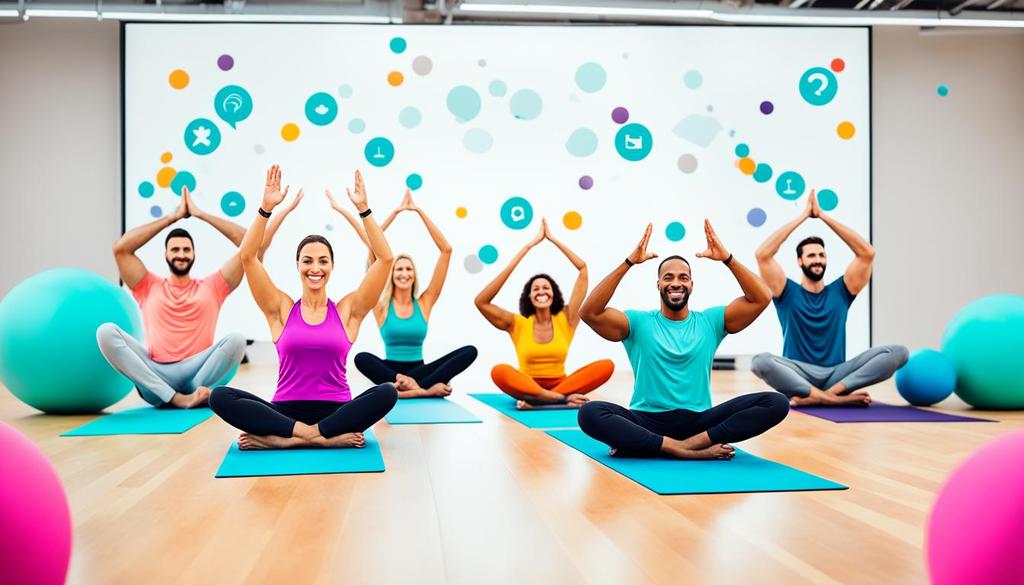
| Resource | Type | Description | Best For |
|---|---|---|---|
| YogaGlo | Streaming Classes | Offering thousands of classes from world-renowned teachers, all skill levels. | Comprehensive Learning |
| DailyYoga App | Mobile Application | Guided yoga sessions and a community feature for shared growth and support. | On-the-Go Practice |
| Yoga Journal | Online Magazine | Extensive articles, pose libraries, and meditation guidance for holistic insight. | Diverse Content |
| r/yoga | Online Community Forum | Reddit’s yoga hub for candid discussions and shared experiences. | Peer Interaction |
“The beauty of beginning yoga is the vast array of resources at our fingertips. Online classes can be paused and repeated as needed, allowing for personalized pacing and understanding—a privilege our predecessors never had.”
With the guidance of these online yoga resources, you’ll find the flexibility to practice in any environment, supplementing in-person classes or serving as your primary yoga education. Meanwhile, being part of yoga communities contributes to a richer, more enjoyable, and connected yoga experience, essential for sustaining motivation. Dive into these platforms and embrace the transformative journey of yoga for beginners.
Incorporate Yoga into Your Fitness Regimen
Embracing a holistic approach to fitness, a yoga fitness regimen becomes a quintessential element for those seeking balance and well-rounded health. When yoga is smartly integrated with traditional workout routines, it provides a multifaceted approach to wellness. This synergy between yoga and other exercise forms creates a harmony that benefits the body and mind, offering one a comprehensive fitness package.
Complementing Cardio and Strength Training with Yoga
Introducing cardio yoga into a routine brings a dynamic fusion of heart-pumping fitness with the mindfulness of yoga. Cardio exercises raise the heart rate, enhance endurance, and torch calories, while yoga postures within these routines help in improving flexibility, balance, and strengthening the core muscles.
Similarly, strength training yoga offers an array of poses known for building muscle and fortifying the bones. The resistance element inherent in such poses as Plank, Warrior, and Chair, encourages lean muscle growth, complementing traditional weightlifting and bodyweight exercises in one’s regimen.
Balancing Intense Workouts with Yoga’s Restorative Poses
Accompanied by intense physical activities, there’s an increasing need to allot time for recovery through restorative yoga. This gentle practice includes poses such as Child’s Pose, Supine Twist, and Legs Up the Wall which promote relaxation, enhance circulation, and assist with muscle recovery post high-impact workouts.
Designing a regimen that integrates yoga workouts with periods of rest can bring equilibrium to your exercise routine. Below is a table illustrating how elements of yoga can be paired with cardio and strength activities throughout the week for a balanced fitness schedule.
| Day | Activity | Yoga Element |
|---|---|---|
| Monday | Strength Training | Yoga Warm-Up/Cooldown |
| Tuesday | Cardio Intervals | Cardio Yoga Fusion |
| Wednesday | Restorative Yoga | Active Recovery |
| Thursday | Strength Training | Yoga for Muscle Recovery |
| Friday | Long-Distance Cardio | Gentle Yoga Sequence |
| Saturday | Circuit Training | Power Yoga |
| Sunday | Active Rest | Meditative Yoga Practice |
Adopting such a structure harmonizes the intensity of traditional workouts with the restorative and strengthening properties of yoga, ensuring one’s fitness journey is enriching, effective, and above all sustainable.
Conclusion
As we wrap up this guide, your starting yoga journey stands before you like a path of blossoming potential, waiting for you to take the first step. Embracing yoga is not merely about learning to touch your toes or mastering the complex poses; it’s about cultivating a deep connection with yourself. It’s a transformative yoga practice that brings about profound changes in the way you relate to your mind, body, and the world around you. This journey, while personal and unique for everyone, universally begins with that initial leap of intention.
The articles preceding have illuminated the path, making clear the equipment you’ll need, the atmosphere most conducive for practice, and the fundamental poses and principles that form the bedrock of yoga. With this knowledge in hand, the act of beginning a yoga journey becomes less daunting and more an exciting exploration of your own capabilities and resilience. Embracing yoga fits seamlessly into everyday life, offering its myriad benefits to all areas of your wellness and lifestyle.
In conclusion, let this be a gentle reminder that the journey is as critical as the destination. As you progress, remember that every posture, every breath, every moment of mindfulness adds to your growth. We encourage you to begin with confidence and curiosity, knowing that the transformative power of yoga is now at your fingertips. The journey of a thousand miles begins with a single step—may your yoga practice be a rewarding adventure.
FAQ
What do I need to start practicing yoga as a beginner?
To start a yoga practice, you’ll need a few essentials: a yoga mat for comfort and traction, comfortable clothing that allows for a range of movement, and optionally, yoga props like blocks or straps to help with alignment and support. You don’t need to invest a lot right away; just make sure you’re comfortable and have enough space to move around.
Can I practice yoga at home?
Absolutely! One of the wonderful aspects of yoga is its flexibility; you can practice it almost anywhere. To create a conducive space at home, find a quiet, clean area where you can lay out your yoga mat. You might want to enhance the atmosphere with things like calming music, candles, or incense to help you focus and relax.
How often should a beginner practice yoga?
As a beginner, aim to practice yoga a few times a week. This helps you build strength and flexibility while establishing a routine. Listen to your body—if you feel like practicing more or less often, adjust accordingly. Consistency is key in developing your practice.
What are some basic yoga poses for beginners?
Some beginner-friendly yoga poses include Tadasana (Mountain Pose) for stability, Balasana (Child’s Pose) for relaxation, Bhujangasana (Cobra Pose) for spinal flexibility, and Savasana (Corpse Pose) for relaxation and meditation. These poses can help build the foundation for a solid yoga practice.
Are there different types of yoga, and which one is best for beginners?
Yes, there are many types of yoga, from the gentle flow of Hatha Yoga to the more physically demanding Ashtanga Yoga. For beginners, Hatha or Vinyasa Yoga is usually recommended because of the slower pace and focus on basic poses and breathing that allow for a better grasp of yoga fundamentals.
Is yoga beneficial for mental health?
Indeed, yoga is known for its mental health benefits. It has been shown to reduce stress, anxiety, and depression. The meditative aspect and breathwork involved in yoga can help bring mindfulness and a sense of calm, enhancing overall emotional well-being.
How do I know when I’m ready to try more advanced yoga poses?
You’ll know you’re ready to advance in your yoga practice when you feel comfortable and stable in the beginner poses. It’s also essential that you can maintain a smooth and steady breath during your practice. Before moving on to more advanced poses or sequences, it might be beneficial to work with a teacher who can guide you and offer personalized advice.
What common mistakes should I avoid as a beginner in yoga?
Beginners should avoid pushing their bodies into discomfort or pain, skipping warm-up poses, ignoring proper alignment, and being inconsistent with their practice. Remember, yoga is a personal journey, and it’s not about perfection but rather progression at your own pace.
Can I still practice yoga if I’m not flexible?
Of course! Yoga is for everyone, and flexibility is something you develop over time with consistent practice. Yoga isn’t just about flexibility; it’s about strength, balance, and mental clarity as well. Start where you are, and you’ll improve as you go.
Should I join a yoga class or can I practice by myself?
This depends on your personal preference and learning style. Joining a class can provide you with guidance, structure, and community, which can be very helpful for beginners. However, if you’re self-motivated or prefer solitude, there are plenty of resources available that allow you to practice by yourself at home.
What is the best time of day to practice yoga?
Yoga can be practiced at any time of day that suits your schedule and energy levels. Many enjoy morning yoga to wake up their body and set a positive tone for the day. Others prefer evening sessions to help unwind before sleep. Experiment and see what feels best for you.
Are there any dietary recommendations for those practicing yoga?
While there are no strict dietary rules, it’s generally recommended to eat a well-balanced, nutritious diet that supports your yoga practice. Try to avoid heavy meals right before practicing, and stay hydrated. Some practitioners follow a yogic diet, which is vegetarian and emphasizes whole grains, fruits, and vegetables.

